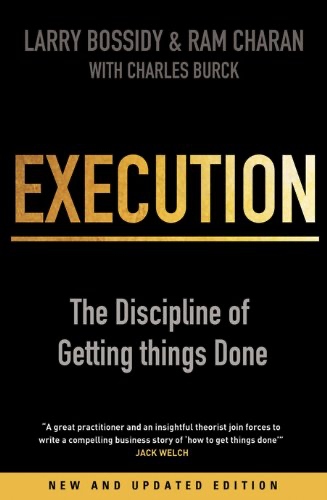
2 Sentence Summary
In “Execution: The Discipline of Getting Things Done,” Ram Charan and Larry Bossidy offer advice on how to be an effective leader. They emphasize the importance of hiring productive team members, making quick decisions, delegating tasks, and following through on commitments.
Summary Read Time: Less than 5 minutes
Actual Book Length: 278
First Published in: 2002
Below is the detailed yet quick summary of the book:
The purpose of the book “Execution: the discipline of getting things done” is to clarify misunderstandings about execution and offer strategies and tools to enhance results. Execution is not a matter of luck, but rather a set of practices and techniques that businesses must excel in to gain a competitive edge. It is a distinct discipline that requires mastery.
Execution is frequently viewed as a way to approach tasks more efficiently, cautiously, or attentively. To grasp the concept of execution, it is important to remember the following:
- Execution is a discipline that is essential to a company’s strategy.
- The primary responsibility of a business leader is execution.
- Execution must be a fundamental aspect of an organization’s culture.
The core processes of a business are closely intertwined and must be integrated with the everyday operations of the business by establishing a discipline of execution that focuses on:
- People
- Strategy
- Budgeting and operations
1 – People
In order to successfully implement a business strategy, it is crucial to identify who will be responsible for achieving it. The people process is crucial to realizing the full potential of a business. Leadership messaging can be used to shape the culture, clarify goals and issues, and change employee attitudes. Behaviors, which are beliefs manifested in action, drive results. It is important to focus on how people execute tasks, not just the outcomes.
As a leader, it is important to coach others and help them learn how to execute effectively, hold them accountable, and provide constant feedback on progress. A common mistake is to be too focused on evaluating current job performance rather than considering whether individuals have the potential to handle future roles.
2 – Strategy
A business’s strategy defines its desired future direction. The corporate-level strategy is used to allocate resources among all of the business units. It is important to involve all relevant parties in the development of the strategic plan. Goals should be based on the organization’s capabilities for delivering results. Most strategies fail because leaders do not accurately assess whether the organization has the ability to execute the plan. Milestones can be set to track the progress of the plan and provide a sense of realism.
3 – Strategy & Operations
The operating plan outlines the steps for implementing the strategy. It is important to have contingency plans in place to handle unexpected events. Budgets may not always accurately reflect the reality of execution as they are often just numbers used in planning exercises. One of the most crucial aspects of an operating plan is to review and debate the assumptions made.





